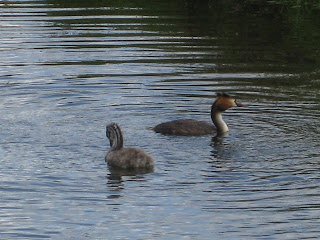 Green Veined White Butterflies
Green Veined White Butterflies Green Veined White Butterflies
Green Veined White Butterflies Red-tailed Bumblebee on Ragwort
Red-tailed Bumblebee on Ragwort White-tailed Bumblebee (?) on Ragwort
White-tailed Bumblebee (?) on Ragwort White-tailed Bumblebee (?) on Ragwort
White-tailed Bumblebee (?) on Ragwort Flesh Fly
Flesh Fly Great Crested Grebes
Great Crested Grebes Coots on Nest
Coots on Nest25th July. I’ve been feeling recently that my bird year list has come to a standstill after an interesting start early in the year. Any gap has certainly been filled this year by the number of insects I’ve been seeing locally, but before finding more I took a look at the lake today and found that two of the Great Crested Grebe young had made good progress. One of them seemed to be acting independently, whilst another eagerly followed one of the parent birds whilst constantly calling and being fed. There was no sign of the third youngster or other parent bird. I didn’t look on the larger lake so maybe they were over there. I couldn’t resist taking a photograph of the Coots on the nest which was surrounded by Flowering Rush Butomus umbellatus. Apart from Mallard, Moorhen, Blacked Headed Gull, there now almost resident Grey Heron and Swift there was nothing else about on the small lake. I did later spot the Sparrowhawk flying overhead. I could find no damselflies on the lake so took a walk across the field to the small area of tall grassland where, as it turned out, I spent quite a bit of time with the insects.
There were still numerous Meadow Brown Butterflies and a number of Small Skippers about. Small White Butterflies were on the wing of course and I found several Green Veined White Butterflies, two of which appear to have been mating. The council workers had been around and cut down all of the Common Ragwort Scenecio jacobaea which was growing near my home, but there was still lots of it here and it was attracting many Bumblebees (White Tailed and Red Tailed I think, but I would appreciate some help) and an assortment of other small insects. I found an interesting specimen on the foot path and on checking this black and white fly with red eyes turns out to be a member of the Flesh Fly family. I’ve found the following information about this family on the internet.
‘Flies of the Diptera family Sarcopagidae (fro the greek sarco-=flesh, phage= eating; the same roots as the word ‘sarcophagus’) are commonly known as Flesh Flies. Most Flesh Flies breed in carrion, dung, or decaying material, but a few species lay their eggs in the open wounds of mammals, hence their common name. Some Flesh Fly larvae are internal parasites of other insects.’
Not something I’d like to share my dinner with. I was faintly aware of the use of insects in forensics and I note that Flesh Flies, because of species preferences for states of decomposition and their predictable life cycle, can be used by forensic scientists to date the time of death, and have also being used in the investigation and detection of murderers. I remember listening to a very interesting radio programme about this very thing.
After a while I moved across the road and found another small area containing some interesting insects and I shall add these later.
There were still numerous Meadow Brown Butterflies and a number of Small Skippers about. Small White Butterflies were on the wing of course and I found several Green Veined White Butterflies, two of which appear to have been mating. The council workers had been around and cut down all of the Common Ragwort Scenecio jacobaea which was growing near my home, but there was still lots of it here and it was attracting many Bumblebees (White Tailed and Red Tailed I think, but I would appreciate some help) and an assortment of other small insects. I found an interesting specimen on the foot path and on checking this black and white fly with red eyes turns out to be a member of the Flesh Fly family. I’ve found the following information about this family on the internet.
‘Flies of the Diptera family Sarcopagidae (fro the greek sarco-=flesh, phage= eating; the same roots as the word ‘sarcophagus’) are commonly known as Flesh Flies. Most Flesh Flies breed in carrion, dung, or decaying material, but a few species lay their eggs in the open wounds of mammals, hence their common name. Some Flesh Fly larvae are internal parasites of other insects.’
Not something I’d like to share my dinner with. I was faintly aware of the use of insects in forensics and I note that Flesh Flies, because of species preferences for states of decomposition and their predictable life cycle, can be used by forensic scientists to date the time of death, and have also being used in the investigation and detection of murderers. I remember listening to a very interesting radio programme about this very thing.
After a while I moved across the road and found another small area containing some interesting insects and I shall add these later.
No comments:
Post a Comment